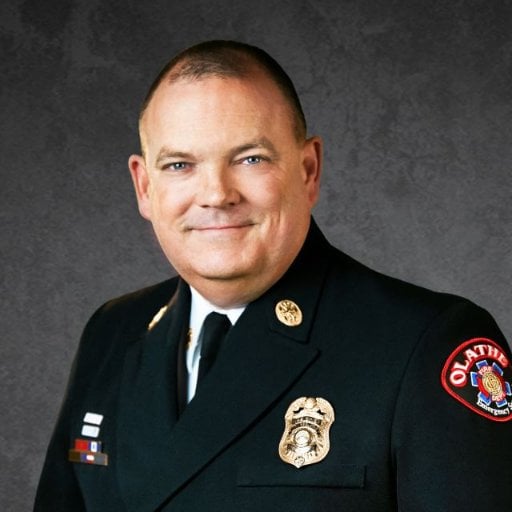 Dr. Jeff DeGraffenreid serves as the fire chief and director of emergency management for the City of Olathe, Kansas. He’s a frequent conference speaker and has authored many articles and textbook chapters on varied emergency service topics. Dr. DeGraffenreid currently sits on the editorial board of the International Fire Service Journal of Leadership and Management, and he has traveled the world working on some of the most significant disasters. He holds undergraduate and master’s degrees from MidAmerica Nazarene University and has earned a doctorate in education policy and leadership from Saint Louis University.
Dr. Jeff DeGraffenreid serves as the fire chief and director of emergency management for the City of Olathe, Kansas. He’s a frequent conference speaker and has authored many articles and textbook chapters on varied emergency service topics. Dr. DeGraffenreid currently sits on the editorial board of the International Fire Service Journal of Leadership and Management, and he has traveled the world working on some of the most significant disasters. He holds undergraduate and master’s degrees from MidAmerica Nazarene University and has earned a doctorate in education policy and leadership from Saint Louis University.
Dr. DeGraffenreid has been chief of the Olathe Fire Department since 2009. Olathe, Kansas, is 20 miles southwest of Kansas City and has a population of 137,472 residents. Olathe has earned a Public Protection Classification (PPC®) of 1, the highest ranking. In addition, its fire department has been accredited by the Commission on Fire Accreditation International (CFAI), a rare double distinction for any community.
With his status leading the Olathe Fire Department, his personal experience, and his advanced education, Dr. DeGraffenreid has thoughts and opinions well worth hearing, and Community Fire Protection News (CFP) recently interviewed him.
CFP: The Olathe Fire Department is both an accredited agency and an ISO Class 1 community. What are the key factors that agencies must understand to accomplish both?
Dr. DeGraffenreid: To be both an accredited agency and an ISO Class 1 community, you must have a departmentwide culture committed to the community and continuous improvement. And you must have the support of your community. In Olathe, we’re blessed with strong municipal leaders and a very supportive community.
CFP: Your community recently improved to an ISO PPC Class 1 from a PPC Class 3 and is one of only seven Class 1 communities out of 1,015 graded departments in the state—that’s less than one-tenth of one percent of Kansas fire protection districts. You’ve created an infographic for public distribution to explain this accomplishment. How was the infographic created, and what are the benefits of communicating with the community?
DeGraffenreid: The ISO infographic was created as a way for us to better communicate with our community. It’s a visual representation of what ISO is and what it means to our customers. Without our customers and their gracious support, we wouldn’t be able to achieve and maintain these accomplishments.
CFP: What unique challenges does the city of Olathe present to providing a safe community?
DeGraffenreid: Every municipality has challenges, and every department within those municipalities has challenges too, such as competing funding priorities and so forth. However, our situation is unique in that our relationships with Olathe’s leaders and other departments are customer-focused. As we collectively focus on the customer, we can address any challenge as a team.
CFP: What new challenges do you see in the future that emergency services will have to address?
DeGraffenreid: We must continue to be strategic and intentional in all that we do because then we can better manage and mitigate whatever challenges we face. Remember, we’re not alone. In some instances, challenges can be managed best by positively leveraging partnerships within the community.
CFP: What is the Olathe Fire Department doing to address the known risk of cancer in the fire service?
DeGraffenreid: In 2018, we became more deliberate in how we take care of ourselves and implemented cancer-risk-reduction practices. The current risk-reduction measures address our life in the station, our time on-scene, when we return to quarters, and other protective measures.
CFP: How do you see your department evolving in the future?
DeGraffenreid: We’ll continue to look for opportunities where our mission and services can intersect with the needs of our customers to make a positive impact in the community. What does that look like? Stay tuned!
CFP: What advice would you give to a new fire chief?
DeGraffenreid: Be engaged with your community. Be engaged with your people. And most important, be engaged with your family.
